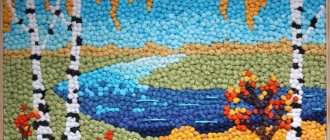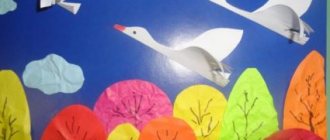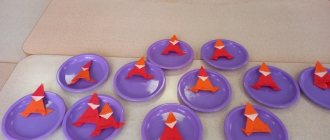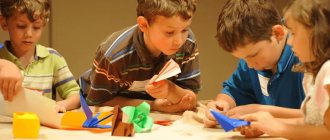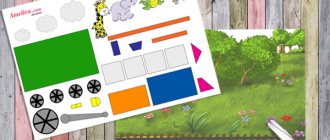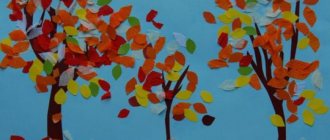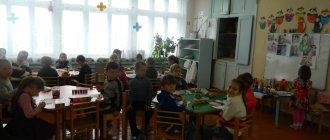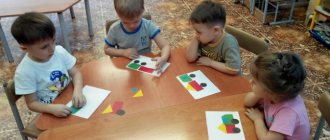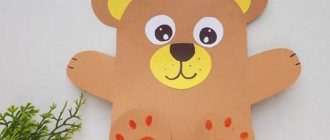Application
Application (from Latin applicatio
- application) is one of the types of visual techniques based on cutting and superimposing various shapes and fixing them on another material taken as the background. The applique can be made of paper, fabric, or various natural materials.
Flower applications are called “floristry”.
To create your compositions, you can use dried leaves, fruits and flowers, straw, poplar fluff, shells, cones, seeds, seeds, herbs, etc. Each material has its own characteristics that must be taken into account.
There are three types of application:
• decorative, combining various elements of decoration;
• subject, consisting of individual images (bird, tree, fungus, house, etc.);
• plot, depicting some action or event (winter landscape, butterfly on the lawn, basket with flowers).
Decorative applique
This is the simplest and most accessible technique, even kids can handle it. The surface of each material is original and unique: soft leaves, rough cones, smooth stones, fluffy feathers and poplar fluff. By making decorations and patterns from different materials, the child learns to combine different shapes and colors, decoratively transform forms according to the laws of rhythm and symmetry.
Decorative applique is characterized by ribbon and central-radial compositions
.
In a ribbon composition, individual elements are repeated horizontally or vertically. In a central-ray composition, the pattern is drawn from the center to the edges, corners or sides of the selected background (it can be a circle, rectangle, rhombus, square, triangle).
Subject application
For subject
For appliques, it is best to select material that is represented in a large form. It is good to use leaves from different plants. For example, these can be large leaves of oak, maple, elm, aspen, chestnut. The shape of these leaves has a distinct configuration that needs to be played out.
Sequence of work: a large leaf is selected and fixed on the main background, and then smaller leaves are placed that convey the characteristic features of the depicted object. For example, the shape of an oak leaf resembles a bizarre figure of a man. Just add a small elm leaf and the little man will have a head. If you place a large elm leaf horizontally, the body of a fish will come out, and its fins can be made from small poplar leaves.
Subject application
Some rules must be followed here.
You should choose natural materials that will match each other in color and texture. Possible combinations: leaves and herbs, shells and pebbles, light large seeds and cone scales. Pay attention to the combination of the color of the materials and the main background. Color is very important, as it helps convey the mood of the picture, the time of year, and the character of the characters in the work.
It is necessary to focus on the main characters of the plot. The main characters stand out from the overall picture by their larger size, bright color, and compositional design.
The composition is usually built taking into account perspective. The parts are not arranged “in a row”. Anything closer will look bigger, and anything further away will look smaller. These are the classic rules of drawing and painting, so to create this type of appliqué you need to be at least a little bit of an artist. The selection and appropriate use of the color of materials and its combination with the main background are very important.
Backgrounds for applications
For the background of the applications, it is recommended to use white thick paper, colored, gray, beige cardboard, velvet paper, sisoflora, lace, birch bark, corn leaves or anything else that you can come up with.
The choice of background is determined by the natural material on which it will “sound” especially brightly. White paper, for example, emphasizes plants' outline, color and shape. Colored, gray and beige cardboard can serve as a background for laurel leaves, silver poplar, and corn, which become a continuation of the color base. Velvet paper has a soft surface on which poplar fluff and feathers can easily be attached. The classic combination is black velvet and straw appliqués.
Sizoflor (pictured left) is pressed fibers of different shades. It can be purchased at flower shops. This material looks especially good if it is fixed with glue on a white or colored background, an amazing effect is obtained.
Lace and white tulle also make a wonderful backdrop. It is recommended to use white wide lace. Tulle can be with different specified patterns, small or large; the main thing is that it is harmoniously combined with natural material. You can secure tulle and lace with glue on a colored or white background.
Birch bark (or birch bark) is an excellent background for plot appliqué compositions. For the base, use plywood or thick cardboard, onto which birch bark is glued. To prepare the background, it takes time, about a day, so that the birch bark is completely fixed.
Even dried corn leaves are used as a background. They can be fixed with glue on cardboard as an independent background. At the same time, corn leaves go well with birch bark.
Photos of works - from the book:
Natalia Vadimovna Dubrovskaya. A big book of applications made from natural materials.
How is the application useful for a child?
Children in early childhood (from about 1 year old) begin to be interested in this type of activity. This is precisely one of the opportunities to develop a child’s fantasy and imagination, study colors and their combinations, as well as the shapes of objects, and develop fine motor skills. Applique classes encourage the development of a child’s thinking processes; he creates a whole from several parts and learns to divide the whole into elements. And, of course, such creativity contributes to the development of speech and spending time together.
By doing appliqué, a child masters the skills of working with paper, scissors and glue, becomes familiar with the properties of paper, learns to work with simple drawings and diagrams, reads symbols and creates a complete image.
